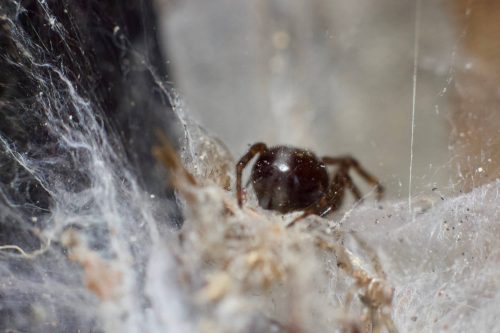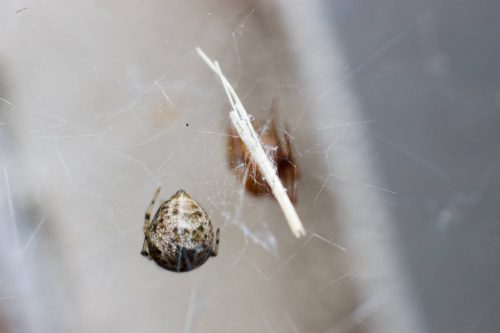I went for a walk in lovely downtown Morris today, and was rather disappointed. Tegenaria has taken over! Where earlier this summer I would have found the delicate, airy cobwebs of my favorite false black widows, there was nothing but these thick, dense sheets of webbing leading to tunnels of silk with these massive spiders lurking within.
OK, fine, they’re still spiders…but they’re far more shy than Parasteatoda. I’d gently and slowly ease my camera lens towards them, but long before the spiders were in focus they’d dart deeper into the tunnel. It was frustrating. I started seeing the utility of this probe lens.
Oh, my. That is one sexy lens.
But no, I do not have that lens, and never will*. So instead I stuck my finger in one tunnel and tore it open, exposing the inhabitant, who promptly leapt out of his hidey-hole, hit the ground running, and streaked out of sight. I saw her long enough to ID her as Tegenaria domestica, the common Barn Funnel Spider, but wasn’t fast enough to get her picture.
But I did find one surprise. Coexisting in the tunnel with the barn spider was this lovely lady, Steatoda borealis. She’s much smaller than the funnel weaver, which may be why she escaped getting eaten, but she seemed quite happy to be shacked up with a completely different species. The web was thick with dead prey, too, so it may be that the surplus of good eatin’ spared her as well.
Unfortunately, there was an annoying trend today of spiders only showing me their butts. I saw one lonely Parasteatoda hanging out by the library, and she also only gave me this view.
For a little change of pace, I also saw lots of Jagged Ambush Bugs (not a spider) over by the courthouse. Strangely, they were all in pairs. I have no idea what they could have been doing, but at least they were colorful.
* I will never own that lens because a) it’s $1500(!), b) I have no disposable income right now, since everything is tied up in this stupid SLAPP suit to the point where my wife is going to have to settle for a $20 birthday present this year, and c) even if I had that much money in my wallet it’s too specialized to tempt me. But it sure looks cool.








Cough You could rent the probe lens online at Borrow Lenses Cough cough.
Yeah, at $95/week. Not gonna happen.
That reminds me of something.
When I was in Florida, I saw some strange-looking orb-weaver spiders. They had black bodies with little bumps, and some red markings on them. The dark bodies were hard to get a picture of against the dark foliage or soil, so I tried to put a white piece of paper or index card behind them to provide contrast. But whenever I did so, they immediately turned around so that only their legs were showing in my direction. Removing the card resulted in them turning around yet again.
Is this behavior a known thing?
(They were probably these guys: spinybacked orbweaver/crab spider; Gasteracantha cancriformis. And they might have been this subspecies/variety, although I don’t recall seeing any yellow on the ones I was trying to photograph)
I do not know your hardware, so this might not be useful to you – for shy thingies, like butterflies and grasshoppers, I am using 2x conversion lens on my Coolpix P900. It allows for making good macro-photography from a greater distance of about 2 m.
I had a need for a similar lens and went instead for a flexible fiberoptic and lens, which oddly was cheaper.
As to spiders, some species in Africa are parasocial and share webs and even prey.
As for the Jagged Ambush Bugs, I checked, Uber had a big rush in your area…
While it won’t solve the working distance problem, you might try the Olympus TG-5. It does in-camera focus stacking, up to 22x. I love mine here in Ecuador.
We have plenty of social spiders here in Ecuador. They might make excellent lab animals, since they normally live together. While it is quite difficult to legally export any live organisms from Ecuador (the paperwork is horrible), there might be other nations that are easier or there might already be captive colonies in the US or other easier nations. You could contact Leticia Avilés to find out: she’s been studying social spiders for decades. She’s in wikipedia.
The mildly deranged penguin points out an alternative to cool-looking expensive bits of incomprehensible kit allowing big hairless apes to upskirt small delicate spiders is to use a compression field. The hairless ape and kit are compressed down to roughly spider-sized, allowing routine boring kit to be used after exciting adventures in stalking and not being eaten. Or, if one wants a really “up close and personal” invasion of the spider’s privacy, compressed to somewhat smaller than a spider, and take exciting pictures using the boring normal kit as one is eaten.
Most compression fields are easily reverted, with some reverting spontaneously after a period of time. This allows one, or one’s partially-digested remains, to be recovered and the photographs developed / downloaded. The reversion can be a bit spectacular, especially if one is still inside the spider and / or, e.g., up a drainpipe. For this reason, insurance is a bit difficult to obtain.
Pro tip: Have a good meal before compression. Otherwise one may wind up munching on flies. However, avoid alcohol, since the same amount of alcohol in a smaller volume rather dramatically increases the blood alcohol level, with all attendant risks.
Hi Again
1500$ for a probe lens! That’s too rich for me. You need the Teslong MS100 pencam. For around 40$ on Amazon, the pencam turns your phone into a portable 200X microscope. It does an excellent job capturing video of small arthropod like ants wasps and of course, spiders.
The pencam has done an excellent job filming a spider who has been living inside one of my Sarracenia pitcher plants. It has been living off the many insects that the plant attracts. The pencam has caught the spider eating an ant, spinning a web and recently hiding from a frog that was planning to live in the pitcher, too. Fortunately, the spider kicked the frog out.
At the risk of being accused of shameless self promotion check out my latest post. It demonstrates how easy it is to film spiders with the pencam. I also included a few of my favorite pictures of animals trapped by the pitcher plants.
https://drmayhem12.wixsite.com/insidepitcherplants/post/spider-update-and-bonus-spider-hunting
And also check out my pencam review.
https://drmayhem12.wixsite.com/insidepitcherplants/pencam-review
Possible useful tip: as a young zoologist in Bristol, I once did a summer project on tunnel web spiders – our arachnologist professor showed us how to coax them out of hiding using … a tuning fork! Choosing the right pitch which corresponded to the wingbeats of the usual victims fooled the spiders, which lunged out to entrap the “prey”. And I can assure you it worked, we collected many many spiders without having to rip open their webs. And these were big guys, I forget the scientific name but they were the largest funnel web spiders in the UK, quite imposing when they jumped out of small holes to reveal their emerald green fangs and 5 cm legs.